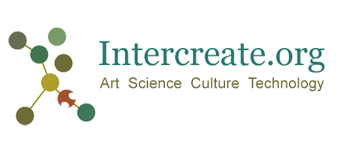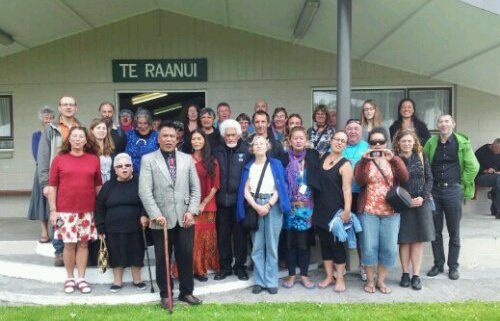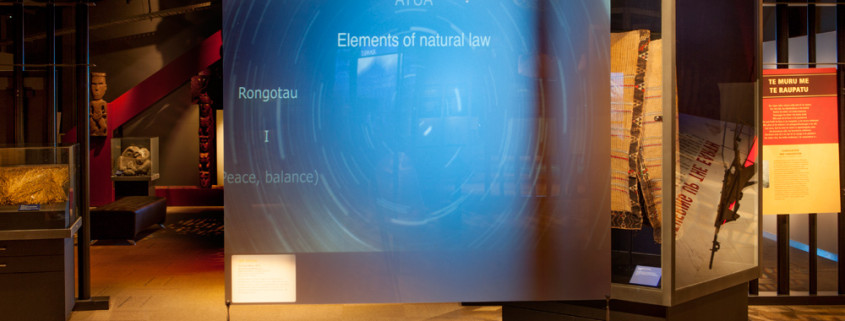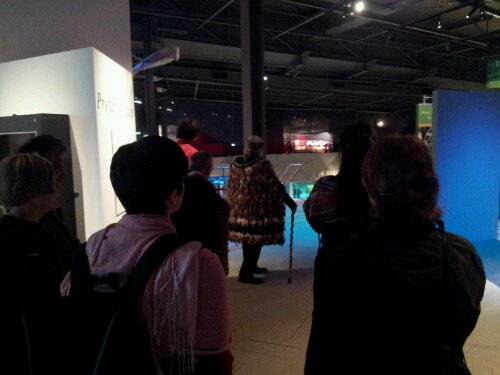3rd nature art works
/in 2013 Exhibition, SCANZ 2013: 3rd nature /by Ian ClothierCurated by Ian Clothier, the works in SCANZ 2013 3rd nature exhibition spiral from the Puke Ariki Museum gallery Te Takapou Whāriki o Taranaki (The Sacred Woven Mat of Taranaki) out onto level 2 and around the natural history and geology galleries, down the stairs on to the landing and beyond into Pukekura Park botanic garden.
SCANZ2013:tomo whakaari
/in 2013 Exhibition, 2013 Images, 2013 Workshops & Events, Featured, SCANZ 2013: 3rd nature /by Ian ClothierSCANZ2013:cyanobacteria
/in 2013 Exhibition, 2013 Images, Featured, SCANZ 2013: 3rd nature /by Ian Clothier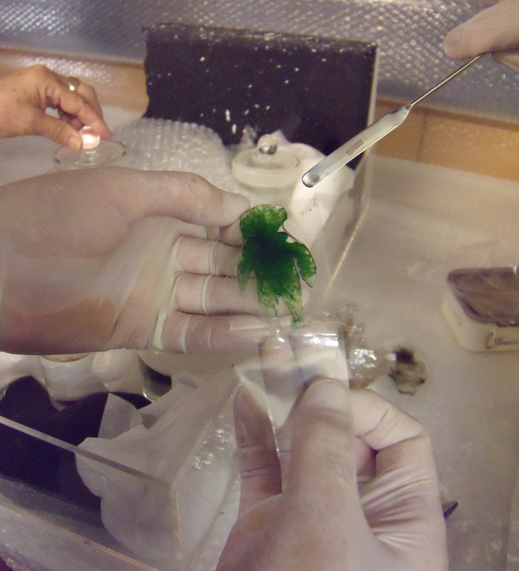
Live cyanobacteria cultured by artist-scientist Hideo Iwasaki is placed into specimen jars in preparation for exhibition
The image above shows preparation work for the 3rd nature exhibition in Puke Ariki. The cyanobacteria was cultured by artist-scientist Professor Hideo Iwasaki of Waseda University, Japan. Professor Iwasaki grows the cyanobacteria in a form derivative of humans, with a head, body, arms and legs.
The cyanobacteria are photosynthetic bacteria, and are ancestors to chloroplasts in plants. A chloroplast captures energy from the sun, and it is said that cyanobacteria helped to make Earth suitable for life. While on exhibition at Puke Ariki the cyanobacteria will be growing slowly, over a period of two months. Instead of the sun, the bacteria will photosynthesise with the light from an animation projected on to them from below.
The work of art and science raises several questions about the boundaries of life and our relationship to living plants. As Professor Iwasaki says: “They will be living at an interface which is hard to be called artificial or natural, drawing complicated patterns, and die.”
3rd nature exhibition
/in 2013 Exhibition, SCANZ 2013: 3rd nature /by Ian ClothierBelow is a sample of works selected for the 3rd nature exhibition. In some cases, previous work by the same person is used. The selection of images below spirals from the projects selected for placement in the local environment, to those to be exhibited in Puke Ariki on Level 2.

This is the bird enclosure in which “Brickets” by Pierre Proske and Damian Stewart will be installed. There is a walkway among trees, and several species of birds living in the trees.

Nigel Helyer will use Intercreate’s data controlled audio system which is located in Pukekura Park. The above image comes from “The Park Speaks” the Intercreate project that initiated the system.

A Walk Through Deep Time involves a walk through 4.5 billion years of the Earth’s history. For SCANZ 2013, Trudy Lane and Halsey Burgund have developed a location-sensitive mediascape for smart devices, which weaves together thoughts from participants past and present.

Image above: Galactic super wind: Matter blasts out of the starburst galaxy M82 in this composite image (X-ray: NASA / CXC / JHU / D.Strickland; optical: NASA / ESA / STScI / AURA / the Hubble Heritage Team; IR: NASA / JPL-Caltech / Univ. of AZ / C. Engelbracht). The project led by Nina Czegledy will visualise galactic wind data.

“3-orange waharua a” is an earlier work by Kura Puke, who will present “Ka Wa Ka Wa” at 3rd nature. “Ka Wa Ka Wa” will be made for the exhibition.
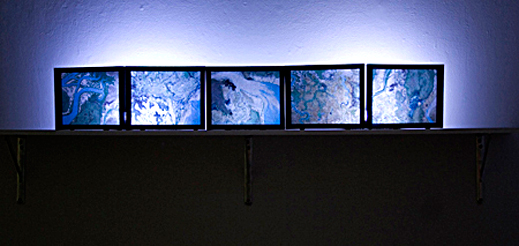
Tracey Benson “Fauxonomy”. This work references places that are protected such as marine reserves, and also looks at land use around estuaries and coastal locations. The project will be hybridised to local Taranaki places for the exhibition.

The image above is from the proposal to create a spiral structure inside Puke Ariki. The structure will house five video works.

This image above is a detail from “After Eden” an installation by Janet Laurence. The Australian artist is known for her work with endangered species, scientific vessels and containers, and incorporating items from the biological collections of museums in installations.

Left: “Medusae” 2010 Crocheted slver wire; right: “Lior” 2010 Crocheted fishing line.Both by Anne Pincus.

Josh Wodak. “2 degrees before 2028.” Digital image. 450mmx650mm. The image is based on projected sea level rise in the Pacific Ocean south of the equator, indicated by the red line. Still image from “Computational Visualization of the Electromagnetic Sensory World of Sharks”.
Still image from “Computational Visualization of the Electromagnetic Sensory World of Sharks”.
3rd nature exhibition background
/in 2013 Exhibition, SCANZ 2013: 3rd nature /by Ian Clothier
This image is of the landing on level 2 of Puke Ariki (hill of Chiefs) Museum. In the centre are native insects and birds, and to the right of the middle is the entrance to the Taonga (Treasures) Gallery.
Curatorial statement 01 – background to the exhibition
The 3rd nature exhibition consists of 11 works within the Museum, 3 works in Pukekura Park and 1 in the local environment. How to exhibit work that spans discipline and culture is of primary importance to the conception of the 3rd nature exhibition. This is more straight forward in a public park such as Pukekura or on the coastline, but is a different matter in museums. The heritage of museums is that objects are sorted into categories that match classifications. Interdisciplinary and intercultural projects are predicated on ideas around hybridity and integrated systems, conceptually diametrically opposed to classification and category. So how do we do this? This is the conversation currently underway, between the curator, artists and museum staff.
Exhibiting are: Te Huirangi Waikerepuru, Mike Paulin, Darko Fritz, Hideo Iwasaki, Sonja van Kerkhoff and Sen McGlinn, Jo Tito, Pierre Proske, Damian Stewart, Tracey Benson, Nigel Helyer, Nina Czegledy, Trudy Lane, Halsey Burgund, Kura Puke, Josh Wodak, Janet Laurence and Anne Pincus. Most are exhibiting in Puke Ariki, with Trudy Lane/Halsey Burgund’s work situated inside Puke Ariki and areas immediately outside the museum, Nigel Helyer is in Pukekura Park botanical garden, as are Pierre Proske and Damian Stewart. Jo Tito will work with the Taranaki landscape.
The exhibition therefore spirals outward from Puke Ariki out into the foreshore, on to Pukekura Park and into the natural world.
The images on this page have been assembled for the exhibitors, so they can see the spaces we are talking about.

A Walk Through Deep Time involves a walk through 4.5 billion years of the Earth’s history. For SCANZ 2013, Trudy Lane and Halsey Burgund have developed a location-sensitive mediascape for smart devices, which weaves together thoughts from participants past and present.

Nigel Helyer will use Intercreate’s data controlled audio system which is located in Pukekura Park. The above image comes from “The Park Speaks” the Intercreate project that initiated the system.
Background to the exhibition
Integrating indigenous perspectives with creative, environmental, technological and scientific views on reality is essential to a sustainable future. This is the view taken by Intercreate in regard to projects. Of particular importance in our view, is integrating the voice of indigenous people. We are fortunate to live in a time where this focus is shared in many countries.
We are therefore determined to integrate art,science, technology and indigenous knowledge in creative projects. 3rd nature is the third major exhibition resulting from engaging with Dr Te Huirangi Waikerepuru on projects. The first was Te Kore Rongo Hungaora: Uncontainable second nature at ISEA 2011 Istanbul. This reportedly was the first time the work of indigenous peoples had been exhibited in the ISEA (International Symposium on Electronic Art) context. There were difficulties in understanding what process we were engaged with exactly, because there was no map for this kind of activity.
Not only was Māori knowledge incorporated into the exhibition, curatorially the show also crossed the boundary between art and science quite dramatically. A work of direct science rather than an art-science project was included: Associate Professor Mike Paulin’s Computational Visualization of the Electromagnetic Sensory World of Sharks was a computer model of a dogfish and a section of the Earth’s electromagnetic field.
Embedded within the computer model (as conceptual background) is the scientific viewpoint that life emerged from water; the shark’s sensory system is integrated with it’s surroundings including the electromagnetic field which is an instance of integrated systems; and clearly the forces of energy are at play. These three themes – life emerging from water, integrated systems and ‘all is energy’ or energistic conceptions – can be seen in Te Taiao Māori (The Māori Universe) chart by Dr Te Huirangi Waikerepuru.
Having stumbled our way through landing a first exhibition (I recall me and Te Urutahi Waikerepuru discussing honestly not knowing what we were doing) – which received some very positive feedback for it’s approach and some of the works, it was decided to attempt a second exhibition at ISEA 2012 Albuquerque.
From discussion with Dr Waikerepuru throughout and after Istanbul, we understood the importance of engaging with local indigenous peoples. Consequently at the outset, this was integrated with concept of Wai which thematically involved works that engaged with notions of water or flow. This resulted in Navajo/Dineh musician Andrew Thomas contributing to the exhibition and Johnson Dennison a Dineh Medicine Man performing ceremony as part of the opening, a Tomo Wakaari (Dawn Opening).
In terms of integrating indigenous knowledge and science, this was robustly demonstrated not by an arts organisation, but by a semi governmental research centre – The Institute of Geological and Nuclear Sciences of Aotearoa New Zealand. They produced a video Raumoko which consisted of interviews of a scientist and Dr Waikerepuru, discussing their views on earthquakes and volcanoes.
Raumoko played through a data projector which showed a video by Indian artist Sharmila Samant, on water, and made in Taranaki Aotearoa New Zealand. It included an interview with Te Huirangi and others. Jo Tito, a contemporary Māori artist currently studying science at university, contributed two videos which played in between Raumoko and Samant’s The Wasteland. This selection reveals a multinational and interdisciplinary approach to water and flow.
Technology connected audio by Thomas and Darren Ward of Aotearoa. Data readings from a tree in Opunake controlled the audio files played in the gallery in Albuquerque, at once joining data, technology, two indigenous cultures and heritage audio. Sensors made by Andrew Hornblow of Opunake included those for tree voltage, temperature and UV on an internet framework previously built by Julian Priest and Adrian Soundy.
This then is the background to 3rd nature. Several key themes from the above will be evident in the upcoming show: integrating Mātauranga Māori, creative projects involving data, engaging with the environment, interdisciplinarity and intercultural exchange. The exhibition attempts to take the integration of art,science, technology and indigenous knowledge (in particular Māori knowledge) further, by co-locating clusters of works across cultural and discipline boundaries throughout the life and earth sciences galleries of Puke Ariki. We intend discussing with the exhibitors and the guardians of the works and galleries, ways to activate interconnections between the collection and the art/science/technology/indigenous works.
Above are images of Puke Ariki and environs locations, to assist the discussion between exhibitors, gallery and curator. They give an indication of the atmosphere of the level 2 galleries, and the way the works spiral out to the wider surrounding landscape. This page is an evolving manuscript, which will change as more information and confirmation comes to hand.
3rd nature: Jo Tito
/in 2013 Exhibition, 2013 Residency, SCANZ 2013: 3rd nature /by Ian Clothier When the opportunity arose to contribute to 3rd Nature, Jo automatically thought, “how wonderful would it be to create in the environment??”
When the opportunity arose to contribute to 3rd Nature, Jo automatically thought, “how wonderful would it be to create in the environment??”
An impermanent creation that would eventually flow back into nature, a moment in time that would be captured on camera and imprinted in the minds and hearts of those who experienced those moments in real time or later on film.
The creations will be totally in the moment, like water flowing down the mountain through rivers and out to sea. It will bring all the elements of her residency project together: Earth, Water, Light, Stones.
She is not sure what will be created, but plans to capture what is being created on camera in some way. She envisions that nature will provide most of the tools she will need to create; light, water, trees, birds, sticks, stones, paint, leaves and has also asked a few of the other artists in residence to collaborate with her as well.
“It’s exciting!” she says. “It’s going to be a wonderful experience that brings nature, creativity, science, technology and human potential into one space. Expect creations that have never been created before, songs that have never been sung before and healing for both land and people.
There will be a science element as well. Jo is a photographer and has spent many years capturing light in photography. “It’s second nature now, when I see light, I see a wonderful photo opportunity and I just want to capture it! So why is photosynthesis so important and how can I explore this amazing part of nature and use this in my photography?”
She is also interested in the science that she believes already exists within te reo Māori. “The word for tree is rākau and within that one word is explained the process of photosynthesis. I do really believe it is as simple as this! That is what I love about te reo Māori. It is such a rich conceptual language. Everything is connected.
This is going to be a journey for her. “Going home to Taranaki is always a personal journey for me. I am always changed when I return to the East Coast from being below our maunga. And I know this place, our maunga (mountain), our whenua (land) and our moana (sea) are special and whatever is going to be created, it will be beautiful.”
3rd nature: Sonja van Kerkhoff and Sen McGlinn
/in 2013 Exhibition, 2013 Residency, SCANZ 2013: 3rd nature /by Ian Clothier
The image above is from the proposal to create a spiral structure inside Puke Ariki. The structure will house five video works.
Introduction
Home within: the hook follows from a work completed by van Kerkhoff and McGlinn for the Second nature Intercreate exhibition in Istanbul. Here a spiral structure is proposed, to contain and reveal five videos which span subjects such as the world of Maori, Taranaki, growing up, and rivers.
3rd nature: Nigel Helyer
/in 2013 Exhibition, 2013 Residency, SCANZ 2013: 3rd nature /by Ian Clothier
Nigel Helyer will use Intercreate’s data controlled audio system which is located in Pukekura Park. The above image comes from “The Park Speaks” the Intercreate project that initiated the system.
Introduction
Nigel Helyer will create a work for “3rd nature”, a customization of an existing structure that enables the playback of audio files to be controlled by live environmental data. Helyer is proposing to locate the speakers in Pukekura Park, so that the local environment will generate the audio. This will be showcased on Sunday February 3rd in Pukekura Park in the afternoon.
3rd nature: Darko Fritz
/in 2013 Exhibition, SCANZ 2013: 3rd nature /by Ian Clothier
Above is an image from the proposal by Darko Fritz to place a large “reload_refresh_sync” symbol in the grounds of Pukekura Park.
Introduction
Darko Fritz has become known for his horticultural units, which involve writing internet error messages with living plants. “reload_refresh_sync” is a reference to the reload button on browsers; to the refresh of information from servers and perhaps by extension, the need to refresh our relationship with the Earth.
Intercreate.org is proudly powered by WordPress
